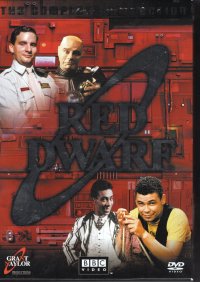 Ah, gentle reader, we have been very light with the movie reports here at MfBJN, and that’s for a good reason: I have actually watched the boxed set entitled Red Dwarf: The Complete Collection which my beautiful wife gave me for my birthday in 2011. Soon, though, it was an incomplete collection, as they made two movies and four more “series” (seasons) of the program all the way up to 2020.
Ah, gentle reader, we have been very light with the movie reports here at MfBJN, and that’s for a good reason: I have actually watched the boxed set entitled Red Dwarf: The Complete Collection which my beautiful wife gave me for my birthday in 2011. Soon, though, it was an incomplete collection, as they made two movies and four more “series” (seasons) of the program all the way up to 2020.
As I have mentioned, the PBS station in St. Louis played an episode of this television program after Doctor Who on Sunday nights. So I recorded a couple of them by programming a videocassette recorder like the ancients did. The first two “series” (seasons, as we spell it in the United States) were released in 1988, so they would have been the ones I have on the old grainy videocassettes. Given that each series is only six episodes, I must have seen quite a percentage of them in those old days. Not long after I got the set of DVDs, I started watching them with my beautiful wife, but she did not care for the common insult of the show, smeghead, so she dropped. And when I got to the start of the third series and saw its abrupt shift in the opening and the different look to it, I shelved it for a decade. But I powered through it this time.
So, the setup: The Red Dwarf is a mining ship, and Dave Lister is the lowest technician on the ship. He smuggles a cat on board and, when it is discovered, he is put into a stasis field for the remainder of the voyage (and will be docked that pay). A radiation leak kills the crew except for Lister, and the computer (known as Holly) releases him three million years later when the radiation levels have cooled. Holly can also project a hologram of a single ship’s crewman, so he chooses Rimmer, Lister’s immediate superior officer, roommate, and foil. Additionally, the pregnant cat gave birth three million years ago, and her progeny evolved to a cat civilization in the ship’s hold, of which only a single representative, called, appropriately enough, Cat, remains. Eventually, they pick up a fifth main character, a service mechanoid named Kryten.
So that’s basically the show: Four or five people dealing with zany creatures they encounter, time rifts, and so on. The first two series were just a couple of sets, but the show’s budget increased over time, and the individual series kind of have themes. The Red Dwarf is stolen for a couple, so they’re pursuing its trail. Or nanobots have rebuilt the Red Dwarf, including the crew (this is the last series in the set). The characters are kind of types: Rimmer is the Flashman type, a blustery nincompoop; Lister is a lower class slob; Cat is a dumb dandy; Holly is a bit daft; Kryten is servile. The humor tends toward the zany situations in which the characters find themselves, the characters playing to their types, and the crazy verbal metaphors they come up with to describe circumstances and situations. It’s funny in spots.
The Wikipedia entry uses the term “retcon” to describe changes between the series, but that implies a continuity that the show itself does not expect or enforce. Kryten, for example, is a one-off character in series 2–the first episode, actually, and he does not appear again in Series II but is a regular character in Series III. In Series III, the original Holly is replaced by a Holly from an alternate universe they encountered in Series II, but the substitution is not explained. Some of the series end in cliffhangers which are sometimes explained quickly at the beginning of the next series–or not. The series that features them hunting for the Red Dwarf starts without showing the precipitating events. Sometimes it tries to explain things–like how they swap out Rimmer for Christine Kochanski in Series VI. So they’re comfortable with having some recurring characters/situations/themes, but they’re not tightly bound to what has gone before (and I understand that later series kind of throw out the last couple of series in this set).
So amusing overall and funny in spots, and I planned to be discouraged about the crew going on for a decade without changing or finding earth, but the different concepts and shifts from series to series kept it fresh.
However, I found binge-watching–and I watched two or three episodes most nights for several weeks–to be kind of difficult. It’s probably easier to enjoy a show like this in its original form–an episode a week, which keeps the repeated tropes from being too obvious.
I am not in a hurry right now to run out and buy the rest of the series. But if I found them at a library book sale for a buck each or in an antique mall for a couple of dollars, I would be tempted. And you all know I cannot resist that temptation, so perhaps the word I’m looking for is fut accompli. That is, a fait accompli in the future.


